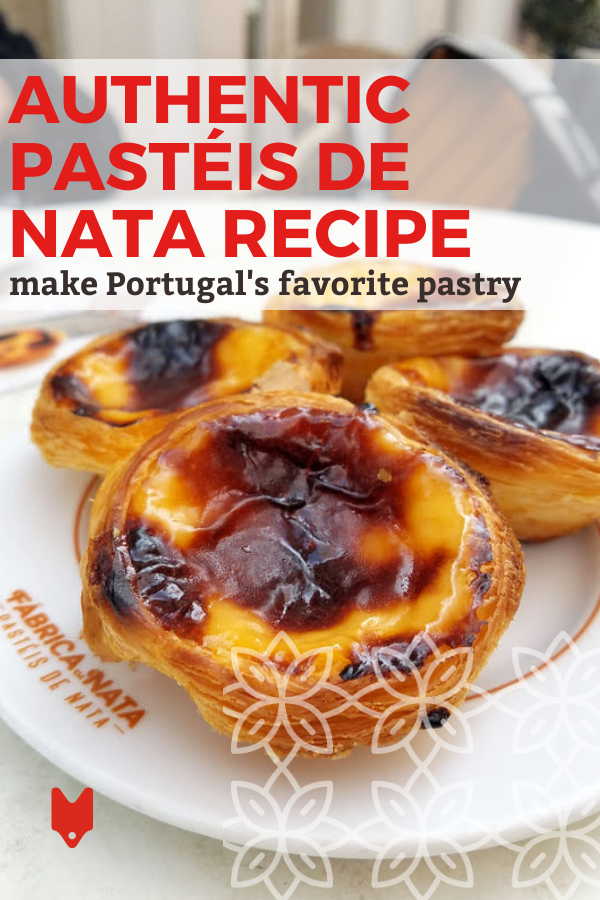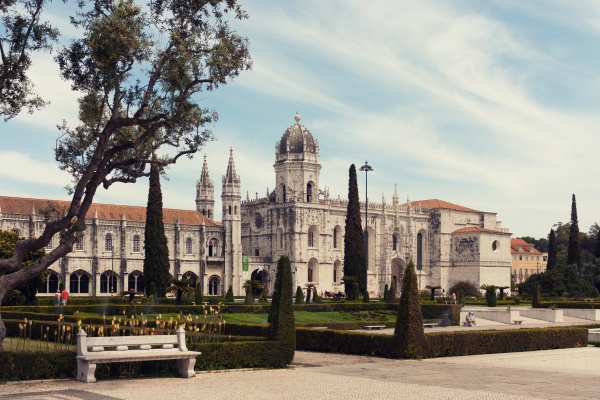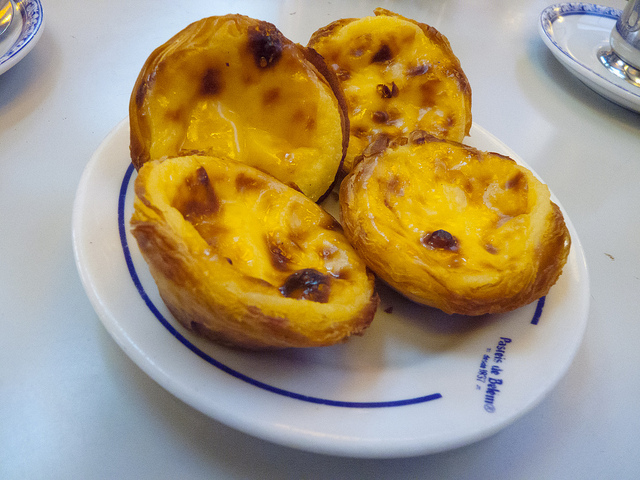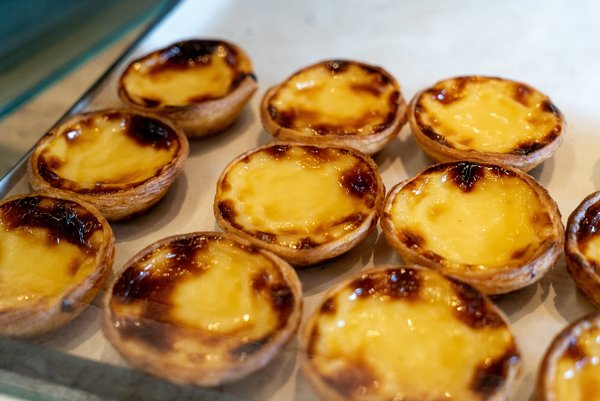Last Updated on November 26, 2025 by Emma Fajcz | Published: October 2, 2020
Few pastries have won over as many hearts (and tastebuds) as Portuguese custard tarts.
Visitors line up outside popular bakeries for them. Locals have strong opinions about which places make the best.
The treats in question are Portuguese custard tarts, or pastéis de nata. What came about as a result of some 18th-century monks doing laundry (yes, really) has grown into one of the most iconic pastries in the world.
While eating a pastel (or multiple pastéis) de nata in Lisbon is understandably a bucket-list dream for so many people, there’s no need to wait until you’re able to travel to Portugal to try them. With this Portuguese custard tarts recipe, you can bring Lisbon’s most beloved pastry to life at home.

The origin of a Portuguese favorite
Remember those laundry-washing monks we mentioned earlier? Let’s go back to them for a second.
Said monks lived at the Jerónimos Monastery in Belém, a seaside neighborhood west of central Lisbon. It was common for them to use egg whites to starch their clothes when washing them, but they soon realized that they had a lot of leftover yolks to deal with.
So the monks did what most people had been doing with egg yolks in Portugal for ages: used them in baked goods. Soon, the first pastéis de nata were born.

In 1820, the Liberal Revolution in Portugal cut off funding to religious institutions. In order to raise money to keep the monastery afloat, the monks began selling their pastries, which before long became a hit.
However, it wasn’t enough, and the monastery ended up closing anyway. When closing up shop, the monks sold their Portuguese custard tarts recipe to the local sugar refinery and called it a day.
Knowing that they had a winner on their hands, the owners of the sugar refinery opened their own bakery just down the street from the old monastery. The bakery is still there today, and if you’ve visited Lisbon, you may have even been there: the original Pastéis de Belém.

Where to eat Portuguese custard tarts in Lisbon
The original Portuguese custard tarts recipe at Pastéis de Belém has become so iconic that many people simply refer to the treats as pastéis de Belém. But it’s not the only place in Lisbon with tarts worth trying.
On our Tastes & Traditions of Lisbon food tour, we cap things off with a pastel de nata at Manteigaria in the Chiado neighborhood. Here, they’re always served warm, and it’s fascinating to be able to watch the bakers hard at work.
Another standout spot is Confeitaria Nacional, Lisbon’s oldest and most storied traditional pastry shop. Not only are the custard tarts themselves unbelievably good, but the place itself is visually stunning with a gorgeously preserved 19th-century interior.
READ MORE: The 4 Best Places to Try Custard Tarts in Lisbon

Ready to try these beauties for yourself (and too impatient to wait until your next trip to Portugal)? Let’s make some pastéis de nata!
Portuguese custard tarts recipe
Makes 12 custard tarts
Ingredients
- 280 grams (1 1/3 cup) white sugar
- 80 milliliters (1/3 cup) water
- 1 teaspoon vanilla extract
- 1 lemon peel, cut into strips
- 1 cinnamon stick
- 355 milliliters (1 1/2 cups) whole milk
- 43 grams (1/3 cup) all-purpose flour
- 1/4 teaspoon salt
- 6 large egg yolks
- One 250 gram (8.5 oz) sheet pre-rolled puff pastry
- Ground cinnamon and powdered sugar, for dusting on top (optional)
Instructions
- Preheat the oven to 290 degrees Celsius (550 degrees Fahrenheit). Lightly grease a 12-cup muffin tin.
- Add the sugar, water, vanilla extract, lemon peel, and cinnamon stick to a saucepan. Bring to a boil and cook without stirring until a thermometer reads 100 degrees Celsius (220 degrees Fahrenheit).
- In a separate pan, thoroughly whisk together the milk, flour and salt. Cook over medium heat for about 5 minutes, whisking constantly. When the mixture is well combined and the milk has thickened, remove from the heat and set aside to cool for 10 minutes.
- Once the milk mixture has cooled, whisk in the egg yolks. Remove the cinnamon stick from the sugar syrup and pour that into the milk mixture as well. Mix until well combined, then strain into a measuring jug.
- Cut the pastry sheet in half across the longer side. Stack the two pieces of dough on top of each other and roll tightly into a log from the short end. Cut the log into 12 evenly sized pieces.
- Place one piece of pastry dough into each of the 12 cups of the muffin tin. Dip your thumb into cold water, then press down into the center of the dough and press outwards to form a small well. Repeat for all 12 cups. The top edge of the dough should extend just barely past the top of the muffin tin.
- Fill each cup 3/4 of the way to the top with the custard filling.
- Bake until the custard starts to caramelize and blister and the pastry crust turns golden brown, about 10–12 minutes.
- Serve warm with powdered sugar and ground cinnamon sprinkled on top if desired.









This Portuguese custard tart recipe was bomb. They turned out amazing and beyond words.
So great to hear that! Thanks for letting us know how they turned out 🙂